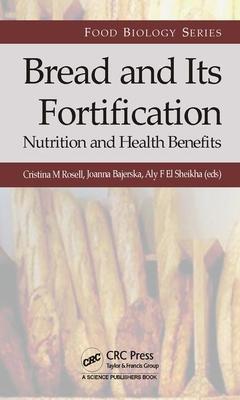Bread and Its Fortification Nutrition and Health Benefits Food Biology Series
Coordonnateurs : Rosell Cristina M., Bajerska Joanna, El Sheikha Aly F.

Today, bread supplies over half of the caloric intake of the world?s population including a high proportion of the intake of Vitamins B and E. Bread therefore is a major food of the world. Bread was the main stables of the ancient Egyptian diet. Around 7,000 BC humans (probably Egyptians) somehow learned to grind grains in water and heat the mix on hot stoves to make unleavened bread. The art of bread making goes back to very early stages of different historical eras. Bread is an important part of the human diet, but for many people, it is much more than just providing macro- and micro-nutrients. Bread with their different types is influenced mainly by the nature of substrate and microorganisms involved in the fermentation. The components of bread depend on the type of bread and on practice and regulations operating in a country. They include basic components and other components (fortifying or enriching ingredients, emulsifiers, anti-fungal agents, anti-oxidants, enzymes and favoring agents, etc.).
Bread and its Fortification for Nutrition and Health Benefits provides updated information in the area of bread and its fortification for health benefits. It serves as a useful reference book with recent advances in the areas of fermentation technology, bread microbiology, bread biotechnology, and bread biochemistry, which is related strongly to human health.
Bread: Between The Heritage Of Past And The Technology Of Present. Role Of Bread On Nutrition And Health Worldwide. Sourdough Bread. Fermentation Process And Bioavailability Of Phytochemicals From Sourdough Bread. Phytochemicals As Functional Bread Compounds: Physiological Effects. Production Of Selenium-Enriched Breads And Their Nutritional And Nutraceutical Properties. Microorganisms Involved In Spoilage Of Bread And Other Bakery Products And Control Measures. Bread Fungal Contamination: Risk Of Mycotoxins, Protection Of Anti-Fungal And Need To Fungal Identification. Bread Fortification. Agronomic Fortification And The Impact On Bread Fortification. Physical Processing Of Grains And Flours Leading Nutritious Breads. Raw Materials Characteristics For Healthy Breadmaking. Non-Conventional Raw Materials For Improving Nutritionally Breads. Effect Of Fibre In Enriched Breads. Traditional Bread In Arabic Countries...Key Of Nutrition. Nutritional And Nutraceutical Features Of Regular And Protein Fortified Corn Tortillas. The Influence Of Bread Enriched With Bioactive Components On Body Weight Control, Carbohydrate Metabolism, and Lipid Profile. Gluten- Free Bread: Technological And Health Aspects.
Date de parution : 10-2015
15.6x23.4 cm
Date de parution : 09-2021
15.6x23.4 cm
Thèmes de Bread and Its Fortification :
Mots-clés :
Biofortifi Cation; Dietary Fi Ber; dietary; Gluten Free Bread; fiber; Fi Ber Enriched; ribofl; Lowering Starch Digestibility; avin; RS; control; Sourdough Fermentation; gluten; Fi Bre; free; Lactic Acid Bacteria; lipid; Sourdough Bread; profile; Penicillium Roqueforti; short; Fortifi Ed; Wheat Bran; Mold Spoilage; Starch Granules; Gluten Free Bread Formulations; Bakery Products; Penicillium Corylophilum; Moisture Content; Bio-fortifi Cation; Gluten Free Formulations; Hetero-fermentative Lab; RDS; Se Concentration; Tamil Nadu



